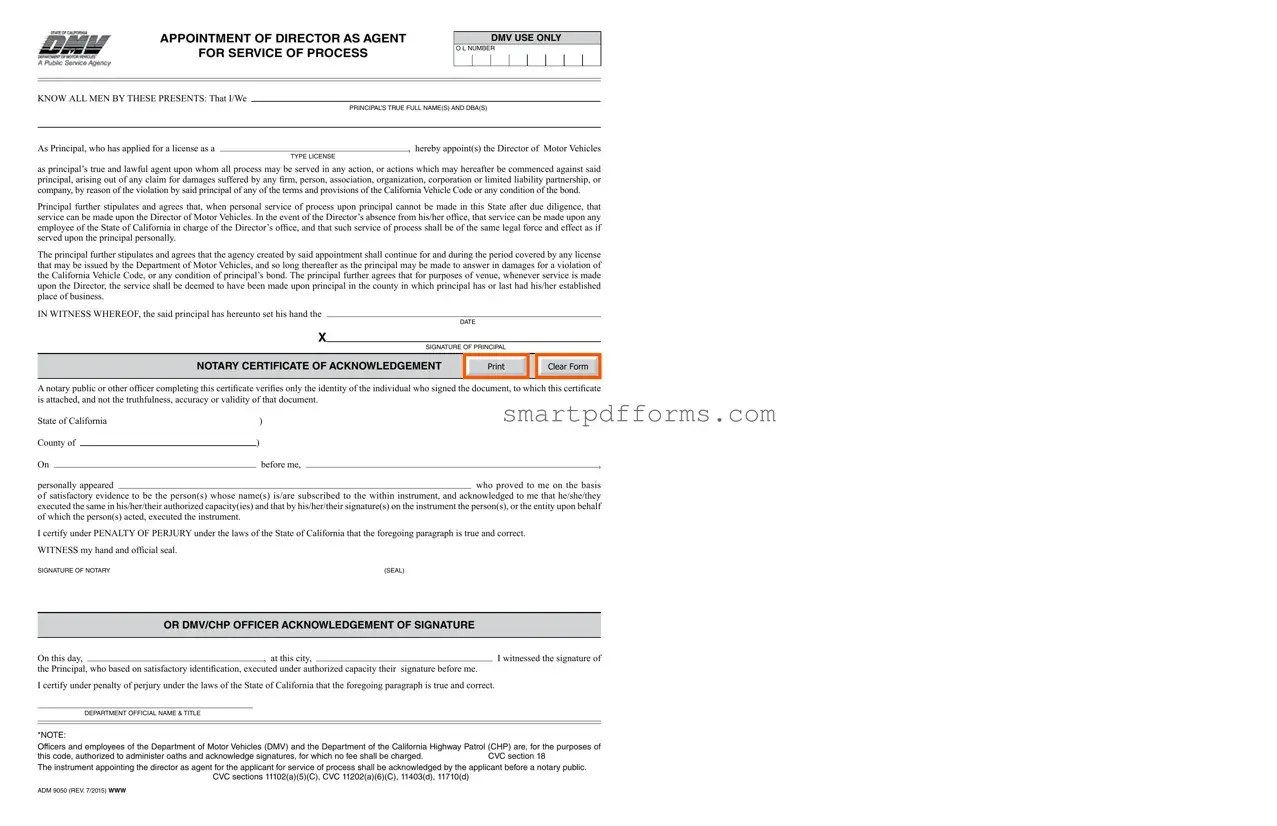APPOINTMENT OF DIRECTOR AS AGENT
FOR SERVICE OF PROCESS
KNOW ALL MEN BY THESE PRESENTS: That I/We
|
PrInCIPAl’s True Full nAme(s) AnD DbA(s) |
|
|
|
As Principal, who has applied for a license as a |
|
, hereby appoint(s) the Director of Motor Vehicles |
|
TyPe lICense |
as principal’s true and lawful agent upon whom all process may be served in any action, or actions which may hereafter be commenced against said principal, arising out of any claim for damages suffered by any firm, person, association, organization, corporation or limited liability partnership, or company, by reason of the violation by said principal of any of the terms and provisions of the California Vehicle Code or any condition of the bond.
Principal further stipulates and agrees that, when personal service of process upon principal cannot be made in this State after due diligence, that service can be made upon the Director of Motor Vehicles. In the event of the Director’s absence from his/her office, that service can be made upon any employee of the State of California in charge of the Director’s office, and that such service of process shall be of the same legal force and effect as if served upon the principal personally.
The principal further stipulates and agrees that the agency created by said appointment shall continue for and during the period covered by any license that may be issued by the Department of Motor Vehicles, and so long thereafter as the principal may be made to answer in damages for a violation of the California Vehicle Code, or any condition of principal’s bond. The principal further agrees that for purposes of venue, whenever service is made upon the Director, the service shall be deemed to have been made upon principal in the county in which principal has or last had his/her established place of business.
IN WITNESS WHEREOF, the said principal has hereunto set his hand the
DATe
X
sIGnATure OF PrInCIPAl
NOTARY CERTIFICATE OF ACkNOwLEDGEMENT
A notary public or other officer completing this certificate verifies only the identity of the individual who signed the document, to which this certificate
is attached, and not the truthfulness, accuracy or validity of that document.
|
|
|
|
|
|
|
|
State of California |
) |
|
|
|
County of |
|
|
) |
|
|
|
On |
|
|
before me, |
|
|
, |
personally appeared |
|
|
|
who proved to me on the basis |
of satisfactory evidence to be the person(s) whose name(s) is/are subscribed to the within instrument, and acknowledged to me that he/she/they executed the same in his/her/their authorized capacity(ies) and that by his/her/their signature(s) on the instrument the person(s), or the entity upon behalf of which the person(s) acted, executed the instrument.
I certify under PENALTY OF PERJURY under the laws of the State of California that the foregoing paragraph is true and correct.
WITNESS my hand and official seal.
sIGnATure OF nOTAry |
(seAl) |
OR DMV/CHP OFFICER ACkNOwLEDGEMENT OF SIGNATURE
On this day, |
|
, at this city, |
|
|
I witnessed the signature of |
the Principal, who based on satisfactory identification, executed under authorized capacity their |
signature before me. |
I certify under penalty of perjury under the laws of the State of California that the foregoing paragraph is true and correct.
DePArTmenT OFFICIAl nAme & TITle
*nOTe:
Officers and employees of the Department of motor Vehicles (DmV) and the Department of the California Highway Patrol (CHP) are, for the purposes of
this code, authorized to administer oaths and acknowledge signatures, for which no fee shall be charged. |
CVC section 18 |
The instrument appointing the director as agent for the applicant for service of process shall be acknowledged by the applicant before a notary public. CVC sections 11102(a)(5)(C), CVC 11202(a)(6)(C), 11403(d), 11710(d)
ADm 9050 (reV. 7/2015) www

